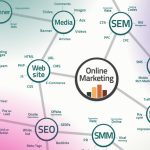Last Updated on 13th May 2021
 Improving Conversion Rate on Your Website
Improving Conversion Rate on Your Website
Building a website and spending valuable man hours on your SEO strategy is a waste of time and money if you are not earning click-throughs, conversions and sales.
If you are bringing in sufficient traffic but not converting, you need to take action.
Below, you will find some powerful tips you should address to improve your conversions. Although these are not the be all and end all, (you may need tweaks elsewhere), they are some of the key areas you should focus on to improve sales.
So here are some tips that will make the groundwork you’ve put in to get the traffic in the first place worth your while:
How To Use The 6 Principles of Persuasion To Boost Conversion
In 1984, psychologist, Dr. Robert Cialdini detailed six principles of persuasion that influence consumers to buy. They are reciprocity, social proof, liking, consistency, authority, and scarcity.
Over the past three decades, these six principles have become a cornerstone of marketing. The same principles can also be used in online marketing to boost conversion rates.
Give and take
Cialdini’s first principle, reciprocity, explains how it is human nature to return favours when somebody feels indebted. Most people are not comfortable being offered a favour and feel compelled to give something back in return.
Online marketers have a prime opportunity to induce this feeling in prospects by offering something for nothing – such as information or a trial period to experience your product.
In doing so, people are more inclined to purchase from you over your rivals. You can achieve reciprocity by providing tips and advice on a blog, replying to questions left on forums or offering advice through social media networks.
Let your customers decide
Social stigma causes people to mimic what others are doing or thinking in order to fit in – hence the expression Sheeple. The psychology of shoppers gives marketers a leverage when canvassing popular opinion.
To do this, hand power over to consumers and invite them to select an option you have chosen for them. This gives you the popular choice which you can then promote.
The next step is to highlight the most popular choice by explaining your product was the choice of the people. Not only will customers who voted for the winning option buy the product, but others will follow suit because that’s what everybody else is doing.
Oh, to be popular
People are more likely to buy merchandise or services from company’s they like. So you have to become likeable. If you have a good sense of wit, use it to your advantage by posting witty remarks on social networks.
However, the key to being liked is through your About Us page. This is your opportunity to tell your story and allow visitors to get to know you. The About Us page should therefore be compelling, inspirational and reflect you as a likeable company customers feel assured by.
Don’t break promises
It’s human nature to go through with something once they have made a commitment in public. Backing out of a promise will cause people to turn their back on you.
You can use this principle as a publicity stunt by announcing an event you are either holding or getting involved with – perhaps a fun run or a charity football match.
By generating interest, people want to see the outcome of your achievements and by doing so will help raise your brand awareness – providing you follow through on your commitment.
Position yourself as an expert
By nature, people look up to authority. If they feel they can trust somebody it makes them secure. Keeping a blog, answering questions on forums and writing for a third party sites enables you to position yourself as an expert in your field.
The keep to writing top quality content is providing information people want to know. Consumers no longer hold sway when it comes to trusting a particular brand, but if they appreciate the advice you give they are more inclined to buy from you.
Propagate demand
When a product is in short supply, consumers are more inclined to buy for fear they are missing out on something. This tactic only works if the product is genuinely scarce and people need or want it.
However, you can still propagate the idea of scarcity by offering a special discount “for a limited time only.” Everyone loves a bargain and will be more inclined to purchase an product that is being offered at cut price for a restricted period.
The psychology of consumers is something every marketer should have knowledge about in order to tap into the minds and buying habits of your audience. If this is an area you feel can be improved, we recommend reading Dr Cialdini’s book, Influence: The Psychology of Persuasion.
More tips to increase conversions
Improve your copy
Improving conversions typically requires concentrating on your website rather than off-page tactics. And magic sales copy is a key component to converting browsers into buyers.
Your copy should talk to the reader in a voice they can trust. Avoid jargon, buzz words and creepy sales copy and talk to them as though they were in your office sitting at the opposite side of your desk. In other words, treat them like a person, not a faceless customer.
Then ask yourself, does your copy provoke desire? Does it describe the benefits of your product and service and explain to readers what is in it for them? If you only concentrate on the features of your product without explaining why prospects need your services, words mean nothing.
Optimizing The Call to Action
Do you have a strong call to action?
People need to be instructed. They do not want to have to make decisions, or think about what they should do next. You stand a better chance of increasing your conversions if visitors act on impulse.
You therefore need a strong call to action that prompts readers to take the next step. It should involve one click or give them a phone number to call. Wherever possible avoid email addresses. If they have to copy paste your email address, open their email, write a message…you get the picture.
A strong call to action involves immediacy, convenience and a clear instruction. Subtly scatter your call to action throughout your sales copy then promote it loud and clear at the end. Also include a call to action on every page of your website.
Write the call to action like a headline
It is well known that powerful headlines improve click-through rates. So why would the same principle not apply for calls to action? Well, it does of course. And with a strong call to action after enticing the reader with copy describing benefits, you will increase your conversion rate.
Use buttons for your call to action
Market research in the last few years has found that mobile users are more inclined to click on a big bright button than they are to follow a link embedded in text. The reason is simple; buttons are easier to tap with your finger than a link.
Ask questions readers want to answer
Stats also show that asking questions that make people feel more important or affect them emotionally are more effective than pitching on offer. For example, rather than asking “Would you like to make £100 an hour?” ask, “Looking for a well-paid job?” The first question is not believable, the second appeals to the readers need.
Improve your offer
Assess your offer. Research your competitors and find out what they are offering at the moment. If competition in your industry is fierce and it has been a while since you conducted market research, it may be that your offer is not appealing to customers.
You may also want to deliberately undercut your rivals to increase sales. Selling more products at a lower profit margin is better than selling less products at a higher profit margin. Do the maths and work out what will be most profitable.
Video for Conversion Improvements
Use video reels
Video is fast becoming the medium of choice for online marketers. It stands to reason given that TV advertising dominated sales conversions for decades. The fact of the matter is, motion pictures are so much easier for consumers to digest. And videos provoke desire like no other form of advertising can touch. Videos aid in engagement and simply adding the word video is thought to increase click through rate on emails and increase dwell time on web pages by a staggering 3 seconds. According to Bloomberg, reported in 2016, 10 billion videos are watched on Snapchat every day.
Explainer videos also help your users to get to grips with how your product or service work and users can leisurely watch these rather than having to read lots of text which may frustrate them. Remember too there are several ways in which people learn. Some learn by watching and others learn by reading. Having an explainer video will most certainly help those who prefer to consume information by watching rather than reading.
Make decision-making simple and quick for your users
Modern day consumers do not want to have to think or search for what to do next. Decisions should be made easy and the call to action positioned button positioned clearly. Signpost everything in clear, easy steps and don’t leave prospects with choices. The average attention span of humans has fallen to that lower than the attention span of a goldfish. People want something which does not make them have to think. You should add the users identified ‘top-tasks’ (i.e. what are the important actions or pathways your users want to take) to your navigation areas or the top area in your home page main content. In fact, you should identify the next steps and put these in prominent positions for your users in each page after of course, ensuring you have met their main informational needs for the current task in the page.
Remove distractions in your landing pages or commercial-intent pages
This is similar to the concept of making decisions simple as described above, but merits its own mention because it is vitally important that prospects are not distracted from the one single action they need to take.
On your landing pages, do not include menus, sidebars and other products or images. Also do not have music or videos playing in the background as this distracts readers from absorbing the words. Keeping to one call to action is thought to increase conversion rate considerably. Again, this really picks up on the item above. Keep it simple and keep it quick for decision making.
Make ads time-sensitive and consider countdown clocks
When consumers are given a deadline for when the offer ends, they tend to act immediately. Otherwise they tend to leave it until later whereby they forget about it completely. There’s also the argument that there is an element of ‘Fear of Missing Out’ which begins to creep in. Will they miss out on that offer if they don’t act now? You’ll see on any hotel booking site there are several elements on booking pages designed to make you want to act quickly. Such as ‘x people are also looking at this hotel’, ‘only one room left at this price’. This all adds up to “If you don’t act now, you may miss out.” marketing.
Focus on Audience Targeting
Write audience targeted commercial pages
Search marketing is designed to attract customers with intent. This makes it easier for marketers to find the right audience. Therefore, when launching an online marketing campaign, focus on one particular service or product and target your landing pages to one specific audience.
Acquire high quality customers
One of the mistakes a lot of online marketers make is focusing on acquiring customers. And it is often the case that you are successful in driving traffic to your site. The problem is, are you visitors the right customers?
Quantity is not better than quality in the digital world and consumers are more choosey about how they spend their money online. If you are using inbound marketing and pull marketing strategies, you need to be targeting customers that have a genuine interest in your brand and products.
Acquiring the right customers requires carefully targeted research and engaging with prospects. Hit social media groups and specialist forums to find prospects that are more likely to show a genuine interest that blindly shooting out hundreds of marketing messages.
Use Social Proof to Convince
Add Testimonials & Reviews (Social-proof)
Word of mouth is the most powerful advertising tool in your marketing arsenal. So include testimonials in your marketing content rather than a few scrolling comments in a sidebar on your blog. People trust their peers far more than they trust brands in the main, so social proof in the form of testimonials and reviews really helps to build some trust in your brand, as indicated by other people like your prospective customers.
Web Design For Conversion Rate Optimisation Guide
Conversions are the key to your digital marketing success and you want every part of your online presence geared toward increasing your conversion rate. These actions users take ultimately determine the success of your marketing efforts and largely decide your ROI – with web design playing a massive a major role.
From the first impression your website gives, to user experience and even contact form design – every stage of the conversion process is directly influenced by the design of your website. So let’s take a look at some key pointers.
First impressions last
Users hit the “back” button more than any other within the first few seconds of visiting a web page. Not only does your site need to load quickly, it needs to give visitors the impression they have come to the right place. You may think the design of your website shouldn’t represent the competence of your business – but that’s not how users see it – and outdated or sloppy design will lose you customers.
User experience goes the distance
If your website design and content is good enough to keep people on the page for more than a few second, user experience needs to step in and take them the rest of the way. Internet users are an impatient and demanding bunch so your website needs to have an intuitive design, functionality and all-round user experience.
This takes good code and content too, but the basis starts with web design. From a logical site structure to the individual elements on each page, your design needs to communicate to users where they should go next in an instant – and be ready to take them there.
Navigation design
A huge part of this comes down to navigation design. We live in a world of multiple devices and users switch from computers to touchscreens on a daily basis – so navigations need to work across the board. Links need to be large enough for fingers of all sizes on touchscreen, while drop menus activated by a mouse hover simply don’t work on touch devices.
Contact forms
Depending on the nature of your business, this is either the most important part of your website, or at least one of them. Contact forms are where people come to make enquiries and much of your online business will start here. So it’s vital your forms are designed to function quickly and accurately. Forms are frustrating for any user so it’s a good idea to ask for as little info as possible and do everything you can to make sure users can complete your forms successfully, in one attempt.
Mobile optimisation
We’ve touched on multiple devices and optimising your design for them is vital as more people take to mobile for their browsing needs. You have a number of options available to you, but the best solution right now is a mobile approach to responsive design. This gives you a single website that alters as device screens get bigger to provide a better optimised experience. It’s not just about layout and content on the screen, but also cleaner code that prioritises weaker devices and internet connections.
There are many other ways in which you can improve click-through rates and conversions. It can depend on your business of course, together with the marketing method you are using.
However, by following the examples above, you will take the right frame of thinking into any marketing campaign and improve your success rate.
Is your dodgy website design limiting conversions?
 Buying products and services online has become integrated into our lives and consumers have more confidence giving their bank details to a faceless online business.
Buying products and services online has become integrated into our lives and consumers have more confidence giving their bank details to a faceless online business.
But they are not daft enough to give their money to just anyone!
As technology advances and new web design trends come into being, it is important for companies to keep up with the times and create a website visitors want to use.
If your website does not meet the criteria of modern day consumers, forget about improving your profits. Online users have demands, want frictionless experiences from websites and if your website does not do want they want, they will look for another site that does.
Ensure your site is easy to navigate
Consumers want convenience and speed. If they cannot easily find what they are looking for on your website, they will not hang around. Information architecture is one of the most vital aspects of a web design and must follow a structured path. Users don’t mind browsing through a site as long as the scent is still warm and appears to be leading to what they are looking for. As soon as the scent goes cold they are far more likely to abandon. And may never return.
If you have a large site with a lot of product pages, or offer a wide range of services in an industry laypeople are unfamiliar with, label your pages with terms the public recognise (or certainly use the lingo of your target audience), and incorporate an internal search function into your site if you can.
Conversion Rate Optimization tools
Conversion Rate Optimisation tools can help to increase profits, but they can quickly become outdated. With new and improved technologies, online tools help to create a better user-experience and make the purchasing process simpler.
The foundation of your website should be flexible so that you can easily remove, add or adapt CRO tools to keep up with incoming trends that will keep you consistently turning a profit.
Landing pages
Landing pages give customers more information and can be used to drive prospects towards your intended goal – either a product page or to capture user data. If the design or the information provided on a landing page is poor quality, consumers will not go any further.
Your landing pages should be designed to drive conversions without breaking advertising rules or forcing a sale. Regardless of whether you are creating a landing page for lead generation or as a click-through page, the content needs to give the information they expect to know, and be compelling enough for the prospect to take action.
Trust symbols & signals
Trust symbols signpost you as a credible trader so include logos of recognised brands you are associated with. This can be either because you use their products to provide a service, sell their goods, or have carried out work for them.
For lesser known brands and the general public, use genuine customer reviews and update them on a regular basis. If you receive a mention in the media or a piece of content goes viral, flaunt the exposure, it is a strong signal that you are a legitimate business customers can trust.
If your website is not converting, the problem can be fixed onsite. Make sure your website is user-friendly, the information you provide is what your customers want to know and show that you are a trustworthy merchant or service provider.
How To Improve Conversion By Building Trust
The good news for online businesses is that consumers are more confident about purchasing online now than they were a few years ago. The reason for that is because online businesses have earned the trust of online shoppers.
It stands to reason that online businesses will increase conversion rate if consumers trust your brand. Not only that, but search engines use “Trust” as a ranking factor.
The higher you rank in search engines, the more trust you earn with consumers. Which means you need to be updating your website with trust indicators and looking for ways of earning trust points to comfort your customers.
Web design
A professional looking design goes a long way to ensuring prospects that you are a genuine company. However, even the free websites from platforms like Wix and WordPress look good.
The difference between a free website and an online shop is that the on-site navigation and additional buttons make a better user-experience – which in itself improves conversions and rankings.
A website that has clearly been invested in is a strong indication to visitors that you are a genuine business and can be trusted. There are other indicators that help support this however.
Physical address
Showing that you are an organised business gives you extra credence with customers. Identifying your physical address with a pin in Google maps also helps drive traffic to your site in local searches.
Maintain your blog
Consumers look for signs that a business is genuine, and still in operation, by how well maintained the site is. You can do this by adding regular blog content so visitors can check the dates.
Blogs go a long way to earning trust, specifically professional firms that offer specialist services. Adding quality content to your blog offering advice also positions you as an expert in your field which earns the trust of visitors.
Create a genuine voice
Salesman and marketing slogans in general do not have a high trust factor with consumers in general. Hyping up products and services, and using bells and whistles to promote your products is an immediate turn-off. Hype does not influence modern day consumers.
Your brand voice should sound genuine and deliver a message readers trust. Offer advice and tell customers exactly what they can expect. Appeal to their sensibilities and show you can resolve their problems by explaining how you can help rather than by bragging with sales language. Bragging is blagging.
Earn credibility
Word of mouth is still the strongest form of advertising. A survey conducted by Nielson shows that 84% of online consumers trust reviews and recommendations from their friends.
Adding testimonials to your site help earn trust – providing they are genuine. Customers will check. Inbound links earn trust with search engines which increases page rank and will improve conversions.
You can also improve your online credibility by contributing to industry magazines and contacting influencers to write about your product. Although writing for third party sites do not earn you inbound links recognised by search engines, linking to these articles from your site give you creditability with prospects.
Although online consumers are more trusting of online retailers and service providers, competition is still high. To attract customers over your rivals, strong trust indicators give you the edge.
More tips to turn browsers into buyers and conversions
If you are attracting the traffic, but not engaging visitors it’s time for a change. And a solid web design that ticks all the boxes will increase conversions.
If your website is attracting traffic but not converting, it’s time to assess your on-site content and turn browsers into buyers.
It is quite common for web owners to update page elements such as font colour, images, offers and even the shape of your click buttons, but the real focus should be on content and ease of purchase.
To nudge you in the right direction, below are three key fundamentals that should be included on your online store in order to increase conversion rates.
1. Sales copy
The first aim of a marketer should be to ensure the sales copy on your website sells. Whilst the old copywriting adage of describing the benefits of your product to the customer and explaining “what’s in it for me” still holds true, fierce online competition also requires you to explain “why buy from you.”
The key to effective web content is emotion. Your web copy should appeal to your customers sensibilities, needs or desires. Write in short, sharp sentences so that the message is clear and concise and most importantly be persuasive so the reader is compelled to take action.
2. Plan a sales funnel
The modern consumer wants easy answers and directions. They do not want a difficult decision to make. You can do this by creating a sales funnel or purchasing path, and guide prospects to take the next step rather than leading them.
It is often the case that if you rush consumers into making a purchasing decision they are put off and will leave your site immediately. It may be they are not ready to buy and are merely browsing to do some research.
This is where information is important. Drip-feed information bit by bit on a need to know basis. If you sell products that are available from a number of sources, offer a better service than your competitors by providing relevant information on review sites and forums etc at the appropriate moment.
You may also have a product customer’s can trial before they purchase. What better way for a customer to “try before they buy.” This method helps to build trust between you and the customer and by doing so increases the likelihood of converting an enquiry into a sale.
3. Real time virtual assistants
It is easier to sell your products to customers browsing your physical store than it is to people who have been in, picked up a leaflet and left. The same is true for your online store.
Employing a virtual assistant enables you to connect with customers in real time and help them make a purchasing decision. This strategy should be included as part of your sales funnel – so too finding out how far along the purchasing path your customer is.
A well trained VA should be able to determine whether a visitor to your online store is ready to purchase or just looking to compare prices and products. Find out what they know about the product they are interested in and give them information they will find useful when making a decision.
There are numerous methods of increasing conversions, and it depends on the nature of your business and products as to how many steps you should include in your sales funnel and what information will benefit visitors the most at any given stage of the purchasing process.
Tips for measuring online traffic
5 Important Google Analytic Metrics To Look At
 The importance of Google analytics should not be underestimated. The data you can pull from this free tool is SEO gold when it comes to tweaking your digital marketing engine.
The importance of Google analytics should not be underestimated. The data you can pull from this free tool is SEO gold when it comes to tweaking your digital marketing engine.
As search technology becomes more sophisticated, specific data analytics become evidently more useful and/or important. Here are five you should be taking a good look at this year.
User behaviour
Given search engines are fixated with improving user-experience, logic would suggest how visitors use your site is arguably the most important metric search engines use to assess the merits of your website.
One of the key stats is how long readers stay on a page and how many average page views you receive per visit.
If visitors are hanging around to absorb page content and exploring other areas of your site, you can be assured your content is engaging and your SERPS will improve.
Also check bounce rate. If it is high, look into which pages visitors arrive to your site and which they are leaving from. That said, don’t assume that a high bounce rate is a bad thing, particularly if your page meets needs (for example, it could be an article which you want visitors to read if you are a publisher, with few other actions required – perhaps consider measuring this in combination with dwell time to see if people are sticking around on those pages or whether they are pogo-sticking straight out of the page again). A high bounce rate could mean that you have actually met their needs in the first place, so it’s not wise to simply look at one metric in isolation.
All pages
The All Pages metric found in Behaviour>Site>Content>All Pages gives you an overview of visitor activity on each page. This is a highly important metric to use to determine the value of a page.
Pages that are not performing well will have a high bounce rate and low dwell time. Identify any pages that are underperforming and fix them.
Mobile-friendly
The mobile revolution was nailed on last year when Google launched the Mobile Update. Companies should start seeing ways of improving mobile pages from the mobile metrics. Pay particular attention to bounce rate and session duration.
But you should also be looking into what type of device people are using. Screen size has an impact on how much visitors are willing to engage with content on your website.
For example, they may be more willing to read an article or make a purchase on a 10-inch tablet rather than a smartphone with a screen half that size. Is there any way you can improve the user-experience for smartphone owners?
If you’re not mobile-friendly yet, take a bite out of becoming so by ascertaining the devices (sizes, models, types) that visitors are using to come to your site and look to optimise (and render well) for those devices first.
Exit pages
Exit pages are similar to the bounce rate metric only drill information down to the actual pages visitors are leaving from. Bounce rate is only recorded when people visit one page (a page will be counted as a non-bounce after 30 minutes of activity, so you may still find that there are theoretical bounces even if someone loaded the page, went away for half and hour and then reloaded the same page).
Analytics gives you a percentage of people leaving from a particular page in relation to the number of page visits. If a high number of visitors are leaving from your landing pages or midway through the paying process, you can resolve the issue and look at ways of improving conversion.
User Explorer
User Explorer is still in beta testing, but could prove to be a highly useful insight once it is launched worldwide. The data reveals client id’s taken from the device or browser so marketers can determine user activity from specific individuals.
This data you can pull from User Explorer will help companies refine personalised marketing campaigns and customer loyalty programs, or even tap into customers to ask what improvements they would like to see on your site.
If you are not already using Google Analytics to measure your SEO performance, start doing so now. Without performance data, you have no insights that will help improve your SEO and content marketing campaigns.
Remember about seasonality
Whether your business attracts customers online or offline, there is often a seasonal drop. Because of this marketers have to manage their advertising budget so spend is not wasted during low season.
Businesses that are new to online marketing may not be fully aware of seasonal drops. Obviously, if you have performance data from previous years, you may be able to determine if this is something your business suffers – but then again, the lull may have been down to other factors.
Perhaps you were not visible enough in search engines for a while and only sporadically attracted customers through social media. You will need to look at what SEO and social strategies you were running at the time. It is likely that some tactics worked better than others.
So now you are analysing stats and scratching your head. Rather than count traffic numbers, determine the month on month increase in traffic or year on year. If your company typically uses quarterly reports, break these down to months as this is easier to determine the amount of marginal growth for the same period each year.
Key points to remember about traffic
You then need to determine whether an increase was due to a targeted marketing campaign that attracted traffic. Did this have any effect on season, or was it purposely designed for a specific time of year when your industry is mostly in demand?
When working offline, most businesses do not need analysis reports to know when they are about to hit a high season. But do you know whether you are suffering the same fall of traffic in low season.
Traffic will not faithfully increase over reflective periods year-on-year. That is the nature of the SEO beast and there could be any number of reasons why. What you need to determine is the cause of rise and falls.
It could be that there was a technical issue with your computer servers and the downtime resulted in a drop in traffic and conversions. Maybe Google pulled your website offline until you cleared up suspicious inbound links. Finding the root which impacts your flow of traffic is vital to your decision making.
Record keeping
The overriding message here is that without detailed records of SEO strategies, results, and reasons for those results, it is impossible, or at least very difficult, to determine if your online business suffers seasonal lows other than obvious times of year like Christmas, Easter and Valentine’s Day.
You also need to keep details of social media campaigns such as contests, offers and landing pages targeting a specific audience. If these strategies were engaged during a period which you would typically call a low season, but received engagement it is worth doing again.
But without this past data to hand, you can’t be sure that you are experiencing seasonality online. It is therefore important that you track marketing strategies and all elements that affect performance to make sure you do not throw money into an SEO campaign you are not likely to recover simply because it is not the right time of year.
Is Your Bounce Rate Restricting Conversions?
If you are not generating leads, attracting search traffic and scoring the conversions you had hoped from your online business, a good place to start your investigation to resolve this is in your google analytics ‘bounce rates’. This Google Analytics metric is a good indication that visitors to your website are not hanging around. Whilst some argue that this may be because your visitors found exactly what they were looking for so only needed a single page view, in the majority of cases it’s usually a sign that visitors are not satisfied with what they found when they arrived from the referring search engine.
Some SEOs believe that search engines use bounce rate as a metric to determine how relevant your site is against a search query and to assess the usability of your website. If visitors are leaving within the first few seconds of landing, some believe that search engines know you are not providing quality content. The return to search engine results from a site and then visiting another website for the same query is often referred to as ‘pogo-sticking’ in SEO circles. It is important to note that Google have always denied that they use bounce rate or click through rates in any way when ranking websites.
In any case, if, when analysing your bounce rate combined with other metrics such as dwell time in Google Analytics, combined with a low conversion it is likely that having a high bounce rate is not doing you any favours.
So how can you improve bounce rate, encourage visitors to explore your website and guide them along the purchasing path to increase conversions?
Professional web design
Your website is your online storefront and needs to be inviting. If you have an outdated website that does not look professional, is not user-friendly and does not give your brand credibility, visitors will not have any confidence they can trust you. To improve bounce rate, the first thing you need to address is building a website customers will explore.
Mobile-friendly
Your website also has to work on multiple devices. Now that more searches are conducted on mobile handsets than desktop PC’s, web designs need to be responsive and give end-users a digital experience on all types of devices. Check how mobile friendly your website is using Google’s Mobile-Friendly Test.
Speed up load times
Google is encouraging online business owners to improve the load speeds of their website. The launch of Accelerated Mobile Pages (AMP) intends to create a richer experience for mobile users and speed up load times. It does this by stripping out unnecessary 3rd party code with a type of minimalist approach. Web developers are being encouraged to use revised codes designed specifically for the AMP project.
Attract the right visitors
Another reason for high bounce rates is because the traffic you are attracting is not the right audience for you. Understand who your audience are and what they want, then publish custom content and highly targeted keywords that are relevant to search queries your audience is most likely to use. This includes reaching out to your audience using the right channels, so if most of your visitors access your website on mobile phones, publish micro-moment content that is useful, and easily digested on small screens.
Create multiple landing pages
Search engines rank pages rather than websites for keywords. If you sell products that are similar, but not the same, creating a page for each product and using targeted keywords, images and rich content to optimise each page will help search engines categorise the page in search results whereby you will attract the right audience. However, you must ensure that each individual page can stand on it’s own merit in that it provides a rich experience for the user and doesn’t actually end up cannibalising the original page that it is similar to.
Check That The Right Page Is Ranking For Keywords And Search Queries
It is easy to just look at rankings alone (particularly when using ranking tools). However, it doesn’t always follow that the page which is ranking is actually the page that would be the best fit for a conversion on your site. Clearly define a target URL that you want to rank for keywords and then check to see if that is what Google is returning in response to search queries. If it isn’t, this may be because of some issues with internal linking in your site (the links internally may be pointing to the wrong target URL), or it may be that you need to improve the relevance of your target page.
The only way to improve bounce rate, search engine rankings and conversions is to provide customers with a website they do not want to leave. A great looking web design will pique their interest, and if you publish engaging content and design information architecture so visitors can find their way around, you should expect to see better results over time.
Gather Conversion Data with PPC Initially
Increase visibility through PPC campaigns
Okay, let’s take a different tactic. It may be that you actually need to increase traffic before you can improve conversion rate. And that means improving visibility.
Pay-per-click campaigns are the best way of hitting the front page of search engines. Furthermore, ads are pitched in front of prospects specifically identified by search engines based on the users past searches. Therefore you have user intent which increases your prospects of acquiring quality customers.
PPC campaigns also provide valuable data that enables you to determine how effective your campaign ads are and how much traffic they are driving to your site.
This critical data gives you valuable information about your page content. If your ads are driving traffic, but you don’t get conversions, you can identify which landing pages need sales copy to be improved.
Get Help with CRO
You can find out more about our conversion rate optimisation services. Alternatively, complete our contact form or give us a call to get in touch for an initial discussion.












